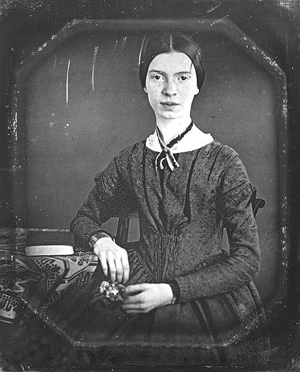Your Turn
For the last activity, you will identify and evaluate the importance of figurative language in a poem by Emily Dickinson, who wrote most of her poetry in her family home in Amherst, Massachusetts, during the 1860s. During that decade, she also became reclusive and dressed only in white. Dickinson’s work was published posthumously (after her death) when her sister discovered the many poems Dickinson had composed and hidden away. "Fame is a fickle food" is the first line of the poem as well as the title. Editors named her poems in this way because Dickinson did not title them. As you read, ask yourself if Dickinson’s ideas about the nature of fame are relevant today. Also think about the connotations of Dickinson’s word choices. Words carry emotional associations and implications in addition to their denotations or dictionary definitions.

Source: Emily Elizabeth Dickenson, Amherst College Archives, Wikimedia Commons
Fame is a fickle food
Upon a shifting plate
Whose table once a
Guest but not
The second time is set.
Whose crumbs the crows inspect
And with ironic caw
Flap past it to the Farmer’s Corn –
Men eat of it and die.
Use your notes to answer the questions that follow. Check your understanding when you are finished.
Here are some hints to help you answer the questions:
- A “fickle” friend is someone who is unreliable, inconsistent, and unpredictable.
- A crow’s “caw” is a harsh, raucous sound.
- Something that is “ironic” is strange or funny and different from what is expected given the circumstances.
- In this poem, Dickinson compares fame to what seemingly unlike item?
- Think about her choice of metaphor. What do we expect of the food we eat?
- She then extends the metaphor of fame from the fickle food to the object that the food/fame sits on in the poem. What does this next image suggest to the reader about the nature of fame?
- In the first stanza, Dickinson extends the metaphor from the plate to the guest at the table. What does she say about the guest that further develops the idea of fame as fickle and temporary?
- In the second stanza, how does Dickinson convey the crows’ disdain for fame? Think about the connotation of “crumbs.”
- The crows dismiss the crumbs of fame in favor of what other food that Dickinson implies is more nourishing?
- What does “it” refer to in the last line of the poem? How is this line an extension of the food metaphor?
- Why do you think Dickinson chose the crow, a vulture-like bird well known for its intelligence and ability to imitate human sounds? The expression “eat crow” (similar to “eating humble pie”) originated in the 1850s and might have been known to Dickinson.
- Your responses to these questions reflect a close reading of the poem and its extended metaphor. You could use those responses to formulate an evaluation of the importance of figurative language to understanding the poem. How might you write the evaluation?
Sample Response:
A fickle food
CloseSample Response:
You might say that we expect our food to taste good and nourish us so that we will be healthy.
CloseSample Response:
A shifting plate. You might say that the image of the shifting plate suggests the temporary and uncertain nature of fame, just as a shifting plate cannot be counted on to hold your food securely.
CloseSample Response:
Fame (the guest) is not present when the table is “set” for a “second time.”
CloseSample Response:
After “inspecting” fame, the crows “flap past it.” You might say that crumbs carry the same connotations as a leftover fragment that is worthless.
CloseSample Response:
The “Farmer’s Corn.” Dickinson is known for her unconventional capitalization of some words in her poems. It is worth noting that “Farmer’s Corn,” a simple, humble, natural food, is capitalized.
CloseSample Response:
The word “it” refers to fame. The metaphor is extended through the word “eat.”
CloseSample Response:
You might say that the intelligent crow is wiser than the humans whose sounds it imitates.
CloseSample Response:
In “Fame is a fickle food,” Dickinson illustrates the temporary and unsatisfying nature of fame by comparing it to a fickle food, one that sits on the “shifting plate” of a guest for whom the table is not set a “second time.” The intelligent crow chooses to eat the “Farmer’s Corn” rather than the “crumbs” of fame. This reflects the poet‘s intent to impress upon the reader how short-lived fame can be.
Close